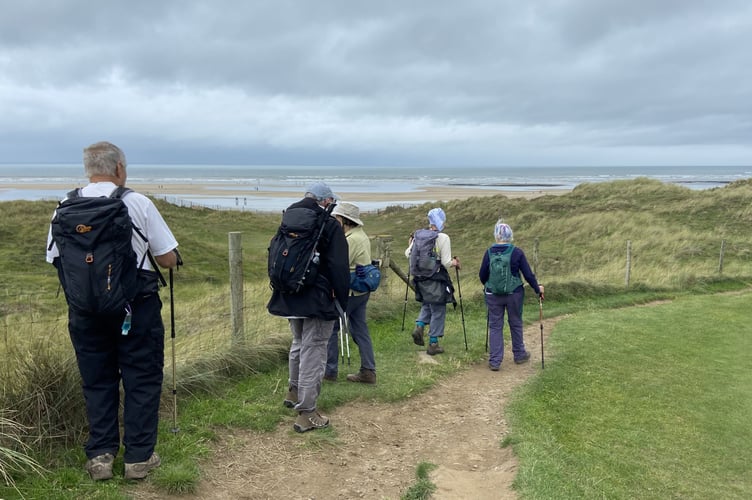SEVENTEEN ramblers joined last week’s walk from Lydford, starting in fine weather on the West Devon Way.
The walk route turns left at the war memorial on School Road, and briefly leaves the way at the crossing by Bolt’s House, instead continuing on the road, before turning right and rejoining the West Devon Way at a stone clapper bridge. This appears on 19th century maps, but may be older.
The bridge, or the ford beside it, would have been where an old route from Tavistock to Okehampton via Lydford crossed an apparently un-named stream. This hollow way is not shown on a 1609 map of Bridestowe, but the section north of Fernworthy Down does appear on a 1788 map. This lane was 18m wide in places.
The group followed the tree-lined modern footpath, which runs parallel to and east of the hollow way, for a few hundred yards, before striking out across the open hillside, aiming for the summit of the down. As the walkers did so, the calls of a blue tit gave way to those of a dunnock, and eventually a skylark.
Having crossed Fernworthy Down, the group continued to Southerly Down along the Granite Way, the route of what was originally known as the Okehampton Railway, subsequently the Devon and Cornwall, and finally the London and South Western Railway. It was closed in 1972, and the route is now a multi-use trail connecting Okehampton and Lydford. More birdsong was listened to on the way, most likely including at least a nuthatch, a great tit and a chaffinch.
The down was ascended in a southerly direction, heading approximately for the source of the Crandford Brook by the King Wall.
The latter has been interpreted as a reave, that is, a long, straight bank of earth and stone, originally built in the Bronze Age most likely as a boundary wall. A cross (pattée, carved in relief on one side of a stone) was discovered In the wall in 2010 by a group of walkers. Presumably it was used to augment the wall, but its origins are a mystery.
A short climb, and the group reached the course of the former (1879-1931) Rattlebrook Peat Railway. This was built to carry peat from Rattlebrook Head beyond Great Links Tor down to Bridestowe and the Okehampton Railway. The Peat Railway was not powered by steam, however - the 950 foot climb back to Rattlebrook Head was made by horsepower.
The summit of Great Nodden was soon gained, and the ramblers took in the views from the top of its dome. Unlike most hills on Dartmoor, there is no tor, as Great Nodden is not made of granite, but of older, softer rocks transformed by the heat and pressure of the igneous intrusion that formed the granite. It is part of a metamorphic aureole, a ring of such rocks surrounding Dartmoor.
The return route followed the Lyd to Nodden Gate, and later once more the Granite Way.Use has been made of the Devon & Dartmoor Historic Environment Record.
As ever new walkers are always welcome. Meet at the post office in George Street, Okehampton on Sunday mornings ready to leave at 9.30am. Please be there in plenty of time so that the group can leave promptly. Next week’s walk will be from Chagford. Where possible, we try to share cars though this cannot be guaranteed. You should be suitably attired for all weather conditions, including sturdy footwear and bring a packed lunch.





Comments
This article has no comments yet. Be the first to leave a comment.